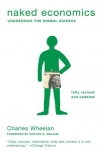Naked Economics Wheelan, Charles (books to read for 13 year olds TXT) 📖

Book online «Naked Economics Wheelan, Charles (books to read for 13 year olds TXT) 📖». Author Wheelan, Charles
So let’s stick with our speed limit analogy and recap what exactly the Fed is charged with doing. The Fed must facilitate a rate of economic growth that is neither too fast nor too slow. Bear in mind: (1) We do not know the economy’s exact speed limit. (2) Both the accelerator and the brake operate with a lag, meaning that neither works immediately when we press on it. Instead, we have to wait a while for a response—anywhere from a few weeks to a few years, but not with any predictable pattern. An inexperienced driver might press progressively harder on the gas, wondering why nothing is happening (and enduring all kinds of public assaults on his pathetically slow driving), only to find the car screaming out of control nine months later. (3) Monetary and fiscal policy affect the economy independently, so while the Fed is gently applying the brake, Congress and the president may be jumping up and down on the accelerator. Or the Fed may tap on the accelerator ever so slightly only to have Congress weigh it down with a brick. (4) Last, there is the obstacle course of world events—a financial collapse here, a spike in the price of oil there. Think of the Fed as always driving in unfamiliar terrain with a map that’s at least ten years out of date.
Bob Woodward’s biography of Alan Greenspan was titled Maestro. In the 1990s, as the American economy roared through its longest expansion in economic history, Mr. Greenspan was given credit for his “Goldilocks” approach to monetary policy—doing everything just right. That reputation has since come partially unraveled. Mr. Greenspan is now criticized for abetting the housing and stock market bubbles by keeping interest rates too low for too long. “Cheap money” didn’t cause inflation by sending everyone to buy PT Cruisers and Caribbean cruises. Instead we bought stocks and real estate, and those rising asset prices didn’t show up in the consumer price index. Add one new challenge to monetary policy: We were speeding even though the gauges we’re used to looking at said we weren’t.
It’s a hard job. Still, that conclusion is a long way from Nobel laureate Robert Mundell’s dire claim that bad monetary policy laid the groundwork for World War II. To understand why irresponsible monetary policy can have cataclysmic effects, we must first make a short digression on the nature of money. To economists, money is quite distinct from wealth. Wealth consists of all things that have value—houses, cars, commodities, human capital. Money, a tiny subset of that wealth, is merely a medium of exchange, something that facilitates trade and commerce. In theory, money is not even necessary. A simple economy could get along through barter alone. In a basic agricultural society, it’s easy enough to swap five chickens for a new dress or to pay a schoolteacher with a goat and three sacks of rice. Barter works less well in a more advanced economy. The logistical challenges of using chickens to buy books at Amazon would be formidable.
In nearly every society, some kind of money has evolved to make trade easier. (The word “salary” comes from the wages paid to Roman soldiers, who were paid in sacks of sal—salt.) Any medium of exchange—whether it is a gold coin, a whale tooth, or an American dollar—serves the same basic purposes. First, it serves as a means of exchange, so that I might enjoy pork chops for dinner tonight even though the butcher has no interest in buying this book. Second, it serves as a unit of account, so that the cost of all kinds of goods and services can be measured and compared using one scale. (Imagine life without a unit of account: The Gap is selling jeans for three chickens a pair while Tommy Hilfiger has similar pants on sale for eleven beaver pelts. Which pants cost more?) Third, money must be portable and durable. Neither bowling balls nor rose petals would serve the purpose. Last, money must be relatively scarce so that it can serve as a store of value.
Clever people will always find a medium of exchange that works. Cigarettes long served as the medium of exchange in prisons, where cash is banned. (It doesn’t matter whether you smoke; cigarettes have value as long as enough other inmates smoke.) So what happened when smoking was banned in U.S. federal prisons? Inmates turned to another portable, durable store of value: cans of mackerel. According to the Wall Street Journal, a single can of mackerel, or “the mack” is the standard unit of currency behind bars. (Some prisons have moved from cans to plastic pouches, because the cans can be fashioned into weapons.) In a can or pouch, mackerel doesn’t spoil, it can be bought on account in the commissary, and it costs about a dollar, making the accounting easy. A haircut costs two macks in the Lompoc Federal Correctional Complex.2
For much of American history, commerce was conducted with paper currency backed by precious metals. Prior to the twentieth century, private banks issued their own money. In 1913, the U.S. government banned private money and became the sole provider of currency. The basic idea did not change. Whether money was public or private, paper currency derived its value from the fact that it could be redeemed for a set quantity of gold or silver, either from a bank or from the government. Then something strange happened. In 1971, the United States permanently went off the gold standard. At that point, every





Comments (0)